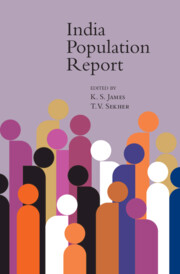4 - Mortality and Epidemiological Transition
India and Its Concerns
Published online by Cambridge University Press: 15 August 2023
Summary
Introduction
Mortality is the first key component among three demographic processes – that is, mortality, fertility, and migration – that contribute to the population change of a country. The worldwide decline in death rates recorded in the 1960s is labelled as ‘mortality transition’ by demographers to signify the path from high and fluctuating mortality to low and stable mortality. The transition in mortality implies enhancements in the quality of life through developments in healthcare, and, accordingly, a lot of importance has been given to it. Moreover, understanding the shift in mortality, age-specific morbidity, and age–cause-specific mortality is essential for drafting changes in public healthcare policy, allocation of healthcare finances, and human resources, thereby averting premature deaths (Anderson and Silver, 1997; Mathers et al., 2005; Désesquelles et al., 2012; Jha, 2012; Dandona et al., 2017; Nkengasong et al., 2020).
Globally, non-communicable diseases (NCDs) account for 7 out of 10 deaths, making them the leading cause of ill health and mortality (World Health Organization [WHO], 2018). In absolute numbers, NCDs cause higher premature mortality in low- and middle-income countries (LMICs) compared to their high-income counterparts. In 2016, 31.5 million NCD deaths occurred in the LMICs – that is, almost three-quarters of global NCD deaths. Since the 1990s, mortality from communicable diseases (CDs) has declined relative to mortality due to NCDs (WHO, 2018). Nevertheless, communicable, maternal, perinatal, and nutritional conditions still account for 38 per cent of all deaths in the LMICs from 2000 to 2015 (WHO, 2016). Thus, most LMICs, including India, are experiencing a dual burden of diseases with higher morbidity and mortality from NCDs and also complementarily a high prevalence of different infectious and parasitic diseases (Agyei-Mensah and Aikins, 2010; Barquera, Pedroza-Tobias, and Medina, 2016).
The inadequate health-management system and the lack of parallel socio-economic changes across all population groups are mainly attributed to this high burden of infectious and parasitic diseases among child and young populations (Defo, 2014). Meanwhile, the lifestyle and behavioural transitions since the 1990s in the LMICs have triggered the rapid increase in NCD-induced morbidity and mortality (Boutayeb and Boutayeb, 2005; Habib and Saha, 2010; Morfeld and Erren, 2019; Malta et al., 2020; Coates et al., 2020). Achieving Sustainable Development Goal (SDG)-3 in the LMICs prerequisites reducing avoidable mortality due to both NCDs and CDs (Norheim et al., 2015; Bennett et al., 2018; Fullman et al., 2017).
- Type
- Chapter
- Information
- India Population Report , pp. 110 - 170Publisher: Cambridge University PressPrint publication year: 2024
- 1
- Cited by



